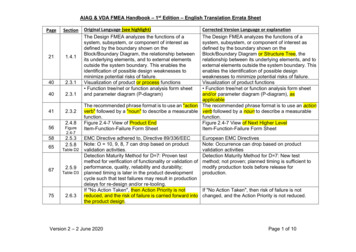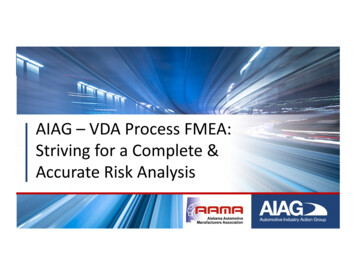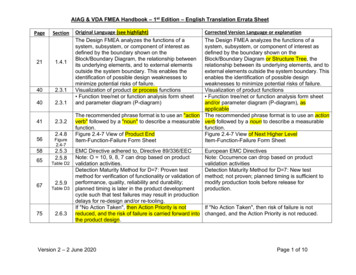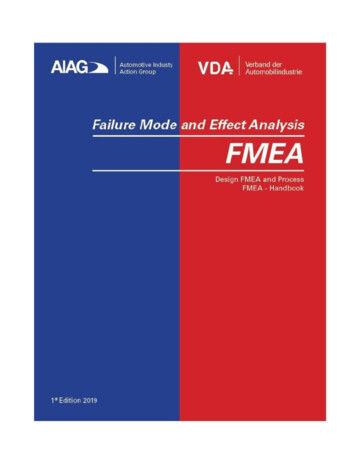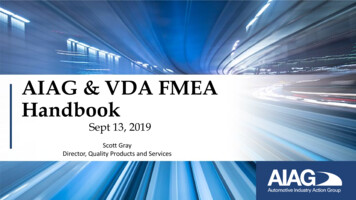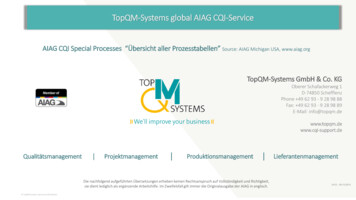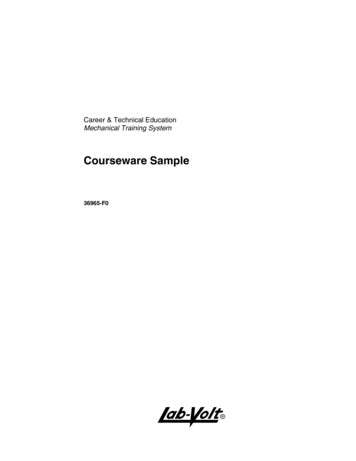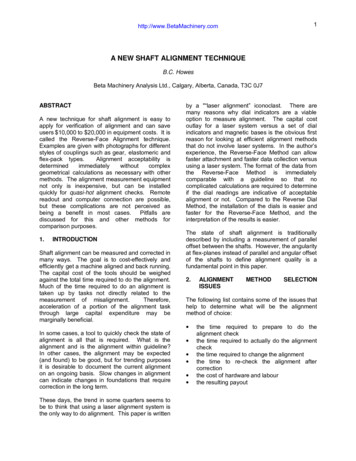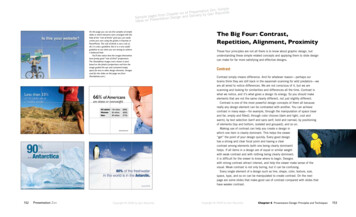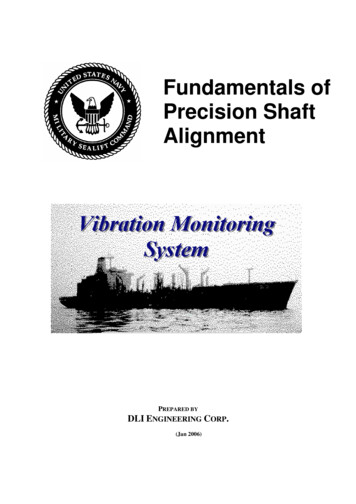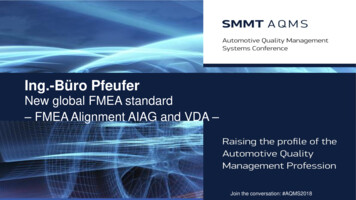
Transcription
Ing.-Büro PfeuferNewglobalFMEAstandardYour Workshop Title Goes Here– FMEA Alignment AIAG and VDA – VDA QMCJoin the conversation: #AQMS2018
Status November 2018FMEA AlignmentAIAG and VDAProject Leader:AIAG: Scott GrayVDA: Jochen Pfeufer VDA QMC
FMEA Alignment of AIAG and VDACurrently suppliers providing products to both N.A. OEM's and German arerequired to assess their products' failure modes and effects differently, basedon differences between the Severity, Occurrence, and Detection rating tables inthe AIAG and VDA FMEA Manuals.This causes confusion and adds complexity to the product development andproduct improvement activities of the suppliers.A common set of FMEA requirements/expectations will enable suppliers to havea single FMEA business process and associated set of methods and tools toproduce robust, accurate and complete FMEA's that would meet the needs andexpectations of any of their customers. VDA QMC
Comparison of the FMEA ManualAIAG and VDA (Ford, GM, FCA)Main focus of the project was the standardization of the criteria„severity“, „occurrence“ and „detection“ within the ranking tables.During the discussion of the issues in the industry the team members ofAIAG and VDA agrees that would be a good opportunity to harmonize andstandardize other parts of the manual in addition. VDA QMC
AttendeesContinental Teves AGDaimler AGDaimler Truck North America*FCA US LLCFord Motor CompanyGeneral Motors*Honda of America Mfg., Inc.Ing.-Büro Pfeufer (on behalf of VDA-QMC) VDA QMCKnorr-Bremse SfN GmbHNexteer Automotive*ON SemiconductorOpel Automobile GmbHRobert Bosch GmbHSchaeffler Technologies AG & Co KGVOLKSWAGEN AGZF Friedrichshafen AGZF TRW
Projects meeting and face to face meetings (1/3) First contacts November 2014 Since May 2015 regular conference calls(weekly / bi-weekly) Meeting in CW 07/2016 (AIAG)Design FMEA main results Review of AIAG and VDA approach Definition of 6 step approach Clarification of inputs and outputs of the 6 steps Review of Ranking Charts (S, O, and D) RPN is replaced by Action Priority (AP) DFMEA: Classification column special characteristics deleted VDA QMC
Projects meeting and face to face meetings (2/3) Meeting in CW 17/2016 (VDA)Process FMEA main results Review of Process AIAG and VDA Chapter Introduction Disposition of PFMEA as 6 step approach PFMEA: Classification column special characteristics remains RPN is replaced by Action Priority (AP) VDA QMC
Projects meeting and face to face meetings (3/3) Meeting in CW 04/2017 (AIAG)Supplemental FMEA-MSR main results Added chapter“Supplemental FMEA for Monitoring and System Response (FMEA-MSR)” Included comments to the draft of the team members/companies Detailing of the rank charts Review and revision of the chapters Meeting in CW 12/2018 (VDA) after yellow book phaseComments from Stakeholder Disposition of Feedback Review of all chapters Editorial and technical revision VDA QMC
6 Steps of FMEA VDA QMC
D1: DFMEA Rank Chart Severity (S)Product General Evaluation Criteria Severity SSEVPotential Failure Effects rated according to what the End User might experience10Affects safe operation of the vehicle and/or other vehicles, the health of operator orpassenger(s) or road users or pedestrians.Noncompliance with regulations.Loss of essential vehicle function necessary for normal driving during expected service life.987654Degradation of essential vehicle function necessary for normal driving during expectedservice life.Loss of convenience function.Degradation of convenience function.Perceived quality of appearance, sound or haptics unacceptable to most customers3Perceived quality of appearance, sound or haptics unacceptable to many customers2Perceived quality of appearance, sound or haptics unacceptable to some customers1No discernible effect. VDA QMCCorporate or ProductLine Examples
D2: DFMEA Rank Chart Occurrence (O) (Extract)Occurrence Potential O for the Product DesignOccurrence criteria for potentialFailure Causes resulting in theFailure Mode, consideringPrevention Controls, rated for theintended service life of theitem(Qualitative rating)OCC101Estimated OccurrenceOccurrence during intended servicelife cannot be determined at thistime, no preventive controls, oroccurrence during intended servicelife of the item is extremely high.Use of Best Practices for product de-sign,Design Rules, Company Standards, LessonsLearned, Industry Standards, MaterialHistory of product usage with-in theSpecifications, Government Regulations andcompany (Novelty of design, application oreffectiveness of prevention oriented analyticaluse case)tools including Computer Aided Engineering,Math Modeling, Simulation Studies, andTolerance StacksProduct ExperiencePrevention ControlsFirst application of new technology anywherewithout operating experience and / or under Standards do not exist and best practices have notuncontrolled operating conditions. Use Case or yet been determined. Analysis is not able to predictoperating conditions vary widely and cannot befield performance.reliably predicted.Identical mature design. Same application,Design proven to conform to Standards and BestPossibility of failure is virtuallyduty cycle, and operating conditions. Testing orPractices, considering Lessons Learned, whicheliminated through preventativefield experience under comparable operatingeffectively prevents the failure from occurring.control and history of failure-freeconditions or mature design with long, failureAnalysis is Capable of ensuring with highseries production.free series production experience underconfidence that the failure cannot occur.comparable operating conditions.Note: A 10, 9, 8, 7 can drop based on process validation activities prior to start of series production. VDA QMC
D3: DFMEA Rank Chart Detection (D) (Extract)Detection Potential D for the Validation of the Product DesignDetection Controls rated according to the best fit for each detection activity performed prior to delivery of the design for productionDETDetection Capability10DETECTION CAPABILITY: No test or test procedure not capable of detecting failure prior to delivery of design for production.9DETECTION CAPABILITY: General test procedure not designed to specifically detect the cause and/or failure mode.87DETECTION CAPABILITY: Procedure is uncertain and/or there is limited experience with the new procedure.TIMING: Post technical release and prior to production launch.DETECTION CAPABILITY: Procedure is uncertain and/or there is limited experience with the modified procedure.TIMING: Post technical release and prior to production launch.4DETECTION CAPABILITY: Proven product design and development verification procedure with new usage profile.TIMING: Prior to technical release.3DETECTION CAPABILITY: Proven product design and development verification procedure with same usage profile as previous product.TIMING: Prior to technical release.21DETECTION CAPABILITY: Detection of Causes (including Noise Factors) with virtual analysis which are highly correlated to operatingconditions and physical testing with high confidence.TIMING: Prior to technical release.Detection of Causes (including Noise Factors) Previously validated. VDA QMC
P1: PFMEA Rank Chart Severity (S) (Extract)Process General Evaluation Criteria Severity SFailure Effects rated for Manufacturing, Assembly, and End User as shown in PFMEASEV10Your Process OwnershipYour PlantThe Next Process Ownership(s)(when known) Ship to PlantEnd User (when known)CustomerFailure may endanger operator (machine Failure may endanger operator (machine Affects safe operation of the vehicleor assembly), Possible long-term effects or assembly), Possible long-term effects and/or other vehicles, the health ofon health of production associateson health of production associatesoperator or passenger(s) or roadusers or pedestrians.9Failure may result in in-plant regulatoryFailure may result in in-plant regulatory Noncompliance with regulations.noncompliancenoncompliance8100% of product affected may have to be Line shutdown greater than fullLoss of essential vehicle functionscrapped.production shift. Stop shipment possible. necessary for normal driving duringField repair or replacement requiredexpected service life.(Assembly to End User) other than forregulatory noncompliance. 1No discernible effectDefective product triggers no reactionNo discernible effect.plan. Additional defective products notlikely. Sort not required. Feedback tosupplier not required. VDA QMC
P2: PFMEA Rank Chart Occurrence (O) (Extract)Occurrence Potential O for the ProcessOccurrence criteria for potential Failure Causes resulting in the Failure Mode within the manufacturing or assembly plant. Consider thecriteria in the Process Experience column and Prevention Controls column, when determining the best Occurrence estimate. There is noneed to evaluate and assign ratings to each of the individual factors.OCCOccurrence rating considering processexperience and preventioncontrols(Qualitative rating)Use of best practices for process design, fixture andtool design and/or effectiveness of set-up andHistory of process usage withincalibration procedures, error-proofing verifications,the companypreventive maintenance, work instructions, andstatistical process control chartingEstimated OccurrenceProcess ExperiencePrevention Controls10Occurrence during manufacturing orNew process withoutassembly cannot be determined, noexperience. New productpreventive controls, or occurrence duringapplication.manufacturing or assembly is extremely high.Best practices and procedures do not exist.1Possibility of failure is eliminated throughpreventative control and history of failure-freeseries production. The failure cannot occur inseries production.Failure cannot occur in series production. Processproven to conform to procedures and BestPractices, considering Lessons Learned.Cause cannot occur becausefailure is eliminated throughdemonstrated preventativecontrol.Note: A 10, 9, 8, 7 can drop based on process validation activities prior to start of series production. VDA QMC
P3: PFMEA Rank Chart Detection (D) (Extract)Detection Potential D for the Validation of the Process DesignDetection Controls rated for each detection activity performed prior to shipment of the product. Detection Controls rated according tothe best fit for each detection activity. Frequency shall be established in the FMEA or control plan. Company/business unit nonconforming material handling procedures apply.Ability toDETDetection criteriaDetectAbsolute10The failure will not or cannot be detected as no testing or inspection method has been established or is known.uncertaintyFailure is not easily detected. Random audits 100% of product. It is unlikely that the testing or inspection method will9Very remotedetect a possible malfunction or fault mechanism.Defect (Failure Mode) detection downstream through visual, tactile or audible means. Ability of testing or inspection8Remotemethod is uncertain or the company/business unit has no experience with the defined testing or inspection method.The method relies on a human for verification and disposition.21 VDA QMCError (Failure Cause) detection in-station through use of controls that will detect error and prevent discrepant productfrom being produced. Proven testing or inspection method from identical processes under the sameVery highoperating/boundary conditions (machines, material). Test/inspection/measuring equipment capability from identicalprocesses confirmed through gauge repeatability and reproducibility evaluations. The required error proofingverification is performed.Discrepant product cannot be physically produced due to design (part geometry) or process (fixture or tooling design).Almost certainThe effectiveness was demonstrated on this product.
Design FMEA Action Priority (AP) -84-51-4M2-44-55-6M2-44-51-4L11-101-10L VDA QMCJustification for Action Priority - DFMEAHigh priority due to safety and/or regulatory effectsthat have a high or very high occurrence ratingHigh priority due to safety and/or regulatory effectsthat have a moderate occurrence rating and high detection ratingHigh priority due to the loss or degradation of an essential or convenience vehiclefunction that has a moderate occurrence rating and moderate detection ratingMedium priority due to the loss or degradation of an essential or convenience vehiclefunction that has a moderate occurrence and low detection ratingMedium priority due to perceived quality (appearance, sound, haptics)with a moderate occurrence and moderate detection ratingLow priority due to perceived quality (appearance, sound, haptics)with a moderate occurrence and low detection ratingLow priority due to no discernible effect
FMEA Action Priority (AP)Action Priority (AP) Action ExpectationHighMediumLowThe team must either identify an appropriate action to improveprevention and / or detection controls or justify and document whycurrent controls are adequate.The team should identify appropriate actions to improve prevention and /or detection controls, or, at the discretion of the company, justify anddocument why controls are adequate.The team could identify actions to improve prevention or detectioncontrols.It is recommended that potential Severity 9-10 failure effectswith Action Priority High and Medium, at a minimum,be reviewed by management including any actions that were taken. VDA QMCThis is not the prioritization of High, Medium, or Low risk.It is the prioritization of the need for actions to reduce risk.
DFMEA Form (Spreadsheet) VDA QMC
DFMEA Form (Software) VDA QMC
PFMEA Form (Spreadsheet) VDA QMC
PFMEA Form (Software) VDA QMC
6 Steps of Supplement FMEA-MSR VDA QMC
MSR1: Rank Chart Severity (S) FMEA-MSRProduct General Evaluation Criteria Severity SSEVPotential Failure Effects rated accord
Meeting in CW 07/2016 (AIAG) Design FMEA main results Review of AIAG and VDA approach Definition of 6 step approach Clarification of inputs and outputs of the 6 steps Review of Ranking Charts (S, O, and D) RPN is replaced by Action Priority (AP) DFMEA: Classification column special characteristics deleted
